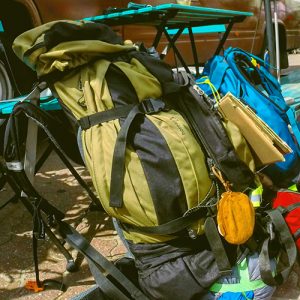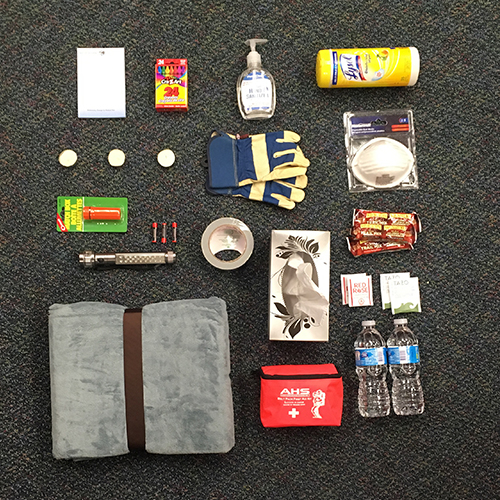The Ultimate List of 72 things You Need in your 72-Hour Emergency Kit
From the Fort McMurray wildfires to floods in Saskatchewan to the BC wildfires to wind storms in Manitoba; extreme weather events harm people in communities across Canada during any season of the year. When weather hits hard, it forces people to leave their homes for safety in other districts and it can also leave them stranded inside their homes with no way out.
Too often, families do not have a kit to sustain them in an emergency. We recommend you pack an emergency kit because chances are, you will need it one day.
Whether you need to flee your home at a moment’s notice or are unable to leave your home at all, we’ve got you covered with the ultimate list of 72 things you need to pack in your 72-hour emergency preparedness kit. It will serve you in most emergency situations.

Food
Make sure you have enough food for each person in your household to eat for three days. Consider any food allergies and dietary restrictions when packing your meals.
- Canned food that can be opened and eaten without cooking
- Dried food
- Energy and protein bars
- Manual can opener
- Coffee and Tea
- Utensils
- Plates
- Cups
- Resealable plastic bags
Water
Each person requires about 4L/1Gal per person per day for drinking and washing.
- Bottled water in large and small bottles
- Lifestraw or other water purifying device
- Water purifying tablets
Warmth
If the electricity is out, you will need a way to stay warm. Have at least two ways to start a fire and include warm clothes for each person.
- Waterproof matches
- Lighter
- Long-burning candles
- Disposable hand warmers
- Blanket or sleeping bag
- Emergency poncho
- One extra set of clothes per person
Shelter
Evacuating a neighbourhood or town to another location might mean there are no hotels or rooms to rent.
- Pop up tent
- Tarp
- 15m/50ft of rope
- Bungee cords
- Work gloves
- Pocket Knife
- Multitool
- Multibit screwdriver
- Wrench
- Hammer
Safety
Be able to find your way without GPS and ensure you can signal emergency crews if necessary.
- Wind up or battery powered flashlight for each person
- Wind up or battery powered radio
- Extra batteries
- $100 cash in small bills and change
- Whistle
- Duct tape
- Zip ties
- Paper map
- Compass
- Road flares
- Light stick
- Cellphone charger
Health
Make sure you can tend to injuries and are prepared with essential medications and sanitation.
- First aid kit
- Extra pair of glasses or contacts
- Record of vaccinations, surgeries, medical history
- List of allergies for each person
- Health insurance information
- Prescription medications
- Non-prescription medication such as pain relievers and antihistamines
- Hand sanitizer
- Moist towelette
- Medicine dropper
- Toiletries
- Chap stick
- Rubber gloves
- Toilet paper
- Garbage bags
- Twist ties
- Bucket and toilet seat
- Disinfectant or bleach
- Dust mask
Important Documents
Keep these documents in a waterproof bag to ensure they are not damaged in storage.
- Copy of your family emergency plan
- List of emergency contacts and phone numbers
- Copy of home insurance policy
- Insurance company claims phone number
- Identification
- Bank records
- Extra keys for your car and home
Stress Relief
Distract your kids and get your mind off the emergency at hand by playing a few games.
- Book
- Deck of cards
- Games
- Puzzles
- Pen/Pencil and notepad
Bonus Item
Pack family photos in your emergency kit. It is comforting for kids (and adults) to see the faces of friends and family in an emergency
Personalize Your Emergency Kit
Think about your unique needs and make sure that your emergency kit is sufficient for your family. Consider the elderly, people with disabilities and special needs, young children, and people with dietary restrictions. If you were stuck for 72-hours, the bag should satisfy the basic needs for each member of your household.
Put it All Together
Now that you have all the essential items for your emergency kit, you need a way to store it and a place to put it. Answers to those questions will depend on your personal preference and where you live but remember, you may need to grab the kit and leave with short notice.

Many people choose to pack their kit into backpacks or bags that are easily carried. Backpacks can also be packed heavier or lighter so each person in your family is able to carry something. An alternative is to stock your kit in plastic storage containers. They store easily, can be staked on a rolling cart, and can be waterproof.
If you live in a house, you may store your kit in an outbuilding like a shed or garage. Or store it inside your home near the front entry or hall closet. Those living in a condo have fewer options for storage. A closet, storage room or even the trunk of your car are good spots for your emergency kit.
With your emergency kit packed and stored, you and your family are ready for and emergency. Check your bag at least once a year to rotate food items and check expiry dates for important documents and medications.
Emergency Kit Names
If “Emergency Kit” doesn’t strike you as an exciting name. Feel free to use one of these. Our favourite is #3.
- Go Bag
- Bug Out Bag
- Just-in-Case Case
- Get Out Of Dodge Bag (GOOD Bag)

